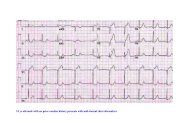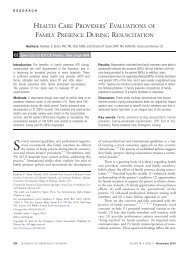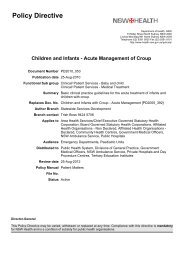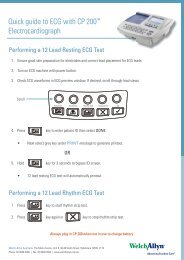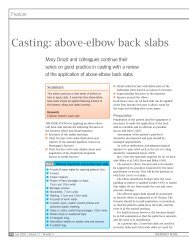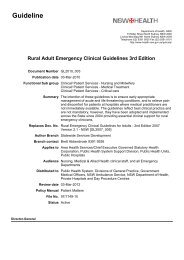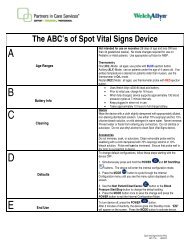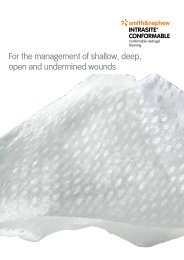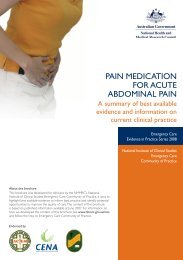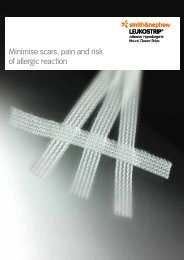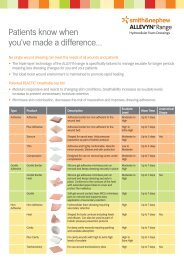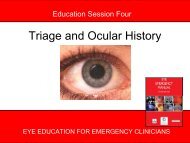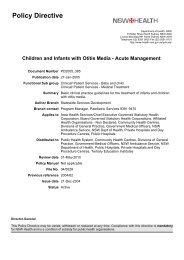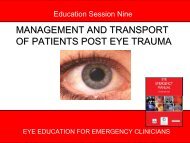Clinical Guidelines for Acute Stroke Management - Living on the EDge
Clinical Guidelines for Acute Stroke Management - Living on the EDge
Clinical Guidelines for Acute Stroke Management - Living on the EDge
Create successful ePaper yourself
Turn your PDF publications into a flip-book with our unique Google optimized e-Paper software.
1.2 Organisati<strong>on</strong> of services <str<strong>on</strong>g>for</str<strong>on</strong>g><br />
transient ischaemic attack (TIA)<br />
There are various models suggested <str<strong>on</strong>g>for</str<strong>on</strong>g> organising<br />
services <str<strong>on</strong>g>for</str<strong>on</strong>g> those with TIA. Such models include direct<br />
hospital admissi<strong>on</strong> to a stroke unit, rapid outpatient<br />
clinics <str<strong>on</strong>g>for</str<strong>on</strong>g> TIA, or management by a general<br />
practiti<strong>on</strong>er.<br />
Admissi<strong>on</strong> to hospital<br />
While <strong>the</strong>re is very str<strong>on</strong>g evidence <str<strong>on</strong>g>for</str<strong>on</strong>g> admissi<strong>on</strong> to<br />
hospital and care <strong>on</strong> a stroke unit <str<strong>on</strong>g>for</str<strong>on</strong>g> all levels of stroke<br />
severity 6 it is unclear if <strong>the</strong>re are benefits <str<strong>on</strong>g>for</str<strong>on</strong>g> those with<br />
TIA and very minor stroke. Analyses undertaken<br />
revealed that mild strokes (presumably including TIA)<br />
did not appear to benefit from stroke unit care<br />
(compared to general ward) in terms of reduced risk<br />
of death al<strong>on</strong>e or death or instituti<strong>on</strong>al care. However,<br />
mild stroke patients managed in stroke units reduced<br />
<strong>the</strong> risk of being dependent if <strong>the</strong>y survived. 6<br />
Fur<strong>the</strong>rmore, hospital admissi<strong>on</strong> to a stroke unit<br />
increased <strong>the</strong> likelihood of undertaking necessary<br />
diagnostic tests (e.g. carotid ultrasound, MRI) and had<br />
higher adherence to protocols and processes of care<br />
c<strong>on</strong>sistent with best practice stroke care compared to<br />
c<strong>on</strong>venti<strong>on</strong>al hospital ward. 24<br />
While mild or recovering symptoms are <strong>on</strong>e reas<strong>on</strong> <str<strong>on</strong>g>for</str<strong>on</strong>g><br />
not administering rt-PA initially, <strong>the</strong>re is some indicati<strong>on</strong><br />
of a correlati<strong>on</strong> between TIA and a subsequent<br />
deteriorati<strong>on</strong> in symptoms in a significant minority of<br />
cases. 25-27 Hence a short hospital admissi<strong>on</strong> may<br />
provide opportunity <str<strong>on</strong>g>for</str<strong>on</strong>g> administrati<strong>on</strong> of rt-PA should<br />
<strong>the</strong> patient deteriorate. One study found a policy of<br />
admissi<strong>on</strong> to hospital <str<strong>on</strong>g>for</str<strong>on</strong>g> 24 hours after TIA is cost<br />
neutral if c<strong>on</strong>sidering rt-PA al<strong>on</strong>e. 28<br />
Rapid TIA clinic<br />
No robust data were found to determine <strong>the</strong> outcomes<br />
of this model of care. One retrospective study in <strong>the</strong><br />
UK found that a clinic was cost effective if all relevant<br />
investigati<strong>on</strong>s had been completed prior to <strong>the</strong> visit<br />
allowing in<str<strong>on</strong>g>for</str<strong>on</strong>g>med decisi<strong>on</strong>s to be made at a “<strong>on</strong>e<br />
stop” service. 29 Ano<strong>the</strong>r case series reported a rapid<br />
assessment clinic was useful to screen <str<strong>on</strong>g>for</str<strong>on</strong>g> patients<br />
eligible <str<strong>on</strong>g>for</str<strong>on</strong>g> carotid surgery but found <strong>on</strong>ly a small<br />
number of patients (4.8%) underwent carotid surgery. 30<br />
There is currently no nati<strong>on</strong>al data <str<strong>on</strong>g>for</str<strong>on</strong>g> stroke or TIA<br />
care provided in emergency departments or outpatient<br />
clinics. Only 5% of hospitals surveyed in 2007 have a<br />
rapid assessment outpatient clinic <str<strong>on</strong>g>for</str<strong>on</strong>g> TIAs or mild<br />
stroke. Availability of such services was significantly<br />
more comm<strong>on</strong> where <strong>the</strong>re was a stroke care unit.<br />
There are no Australian data to indicate <strong>the</strong> average<br />
waiting times from referral to actually being seen in a<br />
clinic. Data from <strong>the</strong> UK indicate while 78% of<br />
hospitals have a neurovascular clinic <strong>on</strong>ly 34% are<br />
seen within 7 days with <strong>the</strong> average waiting time being<br />
12 days. 31 Local services have begun to provide earlier<br />
access to special clinics <str<strong>on</strong>g>for</str<strong>on</strong>g> people with stroke,<br />
especially <str<strong>on</strong>g>for</str<strong>on</strong>g> those assessed as having a lower risk of<br />
stroke. It is vital that any such service should provide<br />
timely access to routine investigati<strong>on</strong>s.<br />
<str<strong>on</strong>g>Management</str<strong>on</strong>g> by primary care<br />
The role of <strong>the</strong> GP in initial assessment and<br />
management of TIA and stroke in Australia is unclear.<br />
In<str<strong>on</strong>g>for</str<strong>on</strong>g>mati<strong>on</strong> collected in <strong>on</strong>e <strong>on</strong>going Australian study<br />
found that TIA represents <strong>on</strong>ly 0.1% of GP<br />
c<strong>on</strong>sultati<strong>on</strong>s. 32 Fur<strong>the</strong>rmore, tests and imaging was<br />
requested in <strong>on</strong>ly a small number of c<strong>on</strong>tacts <str<strong>on</strong>g>for</str<strong>on</strong>g><br />
people with stroke (full blood count 2%; lipid test 1%;<br />
CT brain 2%; Doppler ultrasound of carotid arteries<br />
1%). 33 MRI is not available in some areas especially in<br />
rural and remote centres 34 and GPs are unable to<br />
request MRI. Often people will present to <strong>the</strong> GP<br />
several hours or even days after <strong>the</strong> event due to<br />
underestimati<strong>on</strong> of <strong>the</strong> need <str<strong>on</strong>g>for</str<strong>on</strong>g> rapid assessment and<br />
management. Given <strong>the</strong> small numbers of people with<br />
stroke or TIA who normally present to <strong>the</strong> GP and <strong>the</strong><br />
fact that TIA is often over diagnosed, it appears that<br />
GPs are best placed to provide initial screening and<br />
referral to specialist stroke services <str<strong>on</strong>g>for</str<strong>on</strong>g> full assessment<br />
and early management. L<strong>on</strong>g term management of<br />
risk factors, however, is <strong>the</strong> primary role of GPs.<br />
In c<strong>on</strong>clusi<strong>on</strong>, <strong>the</strong>re is very little direct evidence to<br />
guide administrators and clinicians in <strong>the</strong> most<br />
appropriate organisati<strong>on</strong> of services <str<strong>on</strong>g>for</str<strong>on</strong>g> people with<br />
TIA. It is clear, however, that whichever model is<br />
utilised it should focus <strong>on</strong> rapid assessment and early<br />
management and be based <strong>on</strong> local resources and<br />
needs. Similar to stroke services, development of<br />
networks between general practiti<strong>on</strong>ers and stroke<br />
centres would enable appropriate use of more<br />
intensive resources. Access to services should be<br />
determined <strong>on</strong> <strong>the</strong> basis of risk of stroke. While<br />
recognising its limitati<strong>on</strong>s, <strong>the</strong> ABCD 2 tool is a useful<br />
screening tool that should be used to determine high<br />
and low risk in patients with TIA (see assessment of<br />
TIA secti<strong>on</strong> 3.1).<br />
Secti<strong>on</strong> 1 Organisati<strong>on</strong> of Services<br />
7



